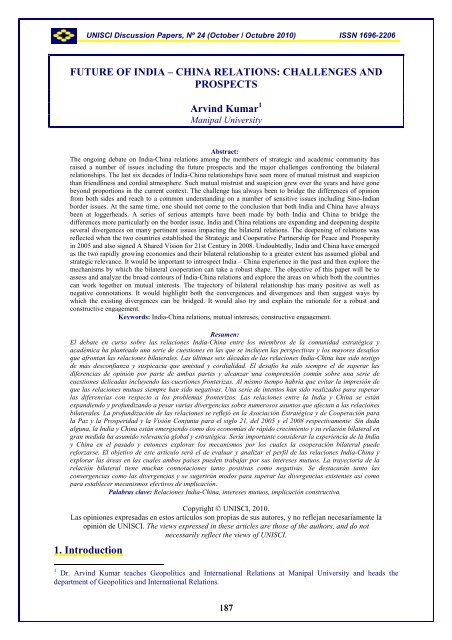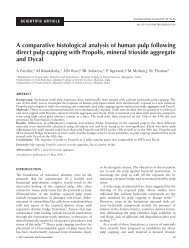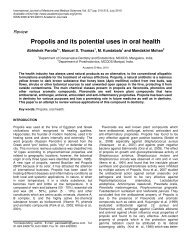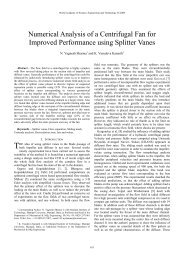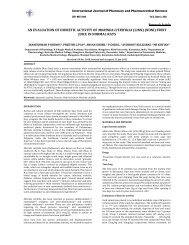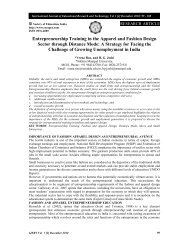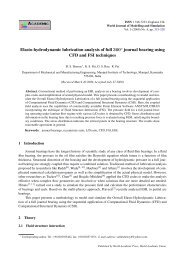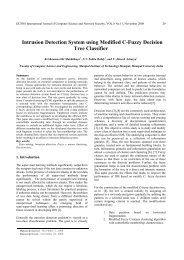future of india â china relations: challenges and prospects
future of india â china relations: challenges and prospects
future of india â china relations: challenges and prospects
Create successful ePaper yourself
Turn your PDF publications into a flip-book with our unique Google optimized e-Paper software.
UNISCI Discussion Papers, Nº 24 (October / Octubre 2010) ISSN 1696-2206FUTURE OF INDIA – CHINA RELATIONS: CHALLENGES ANDPROSPECTSArvind Kumar 1Manipal UniversityAbstract:The ongoing debate on India-China <strong>relations</strong> among the members <strong>of</strong> strategic <strong>and</strong> academic community hasraised a number <strong>of</strong> issues including the <strong>future</strong> <strong>prospects</strong> <strong>and</strong> the major <strong>challenges</strong> confronting the bilateral<strong>relations</strong>hips. The last six decades <strong>of</strong> India-China <strong>relations</strong>hips have seen more <strong>of</strong> mutual mistrust <strong>and</strong> suspicionthan friendliness <strong>and</strong> cordial atmosphere. Such mutual mistrust <strong>and</strong> suspicion grew over the years <strong>and</strong> have gonebeyond proportions in the current context. The challenge has always been to bridge the differences <strong>of</strong> opinionfrom both sides <strong>and</strong> reach to a common underst<strong>and</strong>ing on a number <strong>of</strong> sensitive issues including Sino-Indianborder issues. At the same time, one should not come to the conclusion that both India <strong>and</strong> China have alwaysbeen at loggerheads. A series <strong>of</strong> serious attempts have been made by both India <strong>and</strong> China to bridge thedifferences more particularly on the border issue. India <strong>and</strong> China <strong>relations</strong> are exp<strong>and</strong>ing <strong>and</strong> deepening despiteseveral divergences on many pertinent issues impacting the bilateral <strong>relations</strong>. The deepening <strong>of</strong> <strong>relations</strong> wasreflected when the two countries established the Strategic <strong>and</strong> Cooperative Partnership for Peace <strong>and</strong> Prosperityin 2005 <strong>and</strong> also signed A Shared Vision for 21st Century in 2008. Undoubtedly, India <strong>and</strong> China have emergedas the two rapidly growing economies <strong>and</strong> their bilateral <strong>relations</strong>hip to a greater extent has assumed global <strong>and</strong>strategic relevance. It would be important to introspect India – China experience in the past <strong>and</strong> then explore themechanisms by which the bilateral cooperation can take a robust shape. The objective <strong>of</strong> this paper will be toassess <strong>and</strong> analyze the broad contours <strong>of</strong> India-China <strong>relations</strong> <strong>and</strong> explore the areas on which both the countriescan work together on mutual interests. The trajectory <strong>of</strong> bilateral <strong>relations</strong>hip has many positive as well asnegative connotations. It would highlight both the convergences <strong>and</strong> divergences <strong>and</strong> then suggest ways bywhich the existing divergences can be bridged. It would also try <strong>and</strong> explain the rationale for a robust <strong>and</strong>constructive engagement.Keywords: India-China <strong>relations</strong>, mutual intereses, constructive engagement.Resumen:El debate en curso sobre las relaciones India-China entre los miembros de la comunidad estratégica yacadémica ha planteado una serie de cuestiones en las que se incluyen las perspectivas y los mayores desafíosque afrontan las relaciones bilaterales. Las últimas seis décadas de las relaciones India-China han sido testigode más desconfianza y suspicacia que amistad y cordialidad. El desafío ha sido siempre el de superar lasdiferencias de opinión por parte de ambas partes y alcanzar una comprensión común sobre una serie decuestiones delicadas incluyendo las cuestiones fronterizas. Al mismo tiempo habría que evitar la impresión deque las relaciones mutuas siempre han sido negativas. Una serie de intentos han sido realizados para superarlas diferencias con respecto a los problemas fronterizos. Las relaciones entre la India y China se estánexp<strong>and</strong>iendo y pr<strong>of</strong>undiz<strong>and</strong>o a pesar varias divergencias sobre numerosos asuntos que afectan a las relacionesbilaterales. La pr<strong>of</strong>undización de las relaciones se reflejó en la Asociación Estratégica y de Cooperación parala Paz y la Prosperidad y la Visión Conjunta para el siglo 21, del 2005 y el 2008 respectivamente. Sin dudaalguna, la India y China están emergiendo como dos economías de rápido crecimiento y su relación bilateral engran medida ha asumido relevancia global y estratégica. Sería importante considerar la experiencia de la Indiay China en el pasado y entonces explorar los mecanismos por los cuales la cooperación bilateral puedereforzarse. El objetivo de este artículo será el de evaluar y analizar el perfil de las relaciones India-China yexplorar las áreas en las cuales ambos países pueden trabajar por sus intereses mutuos. La trayectoria de larelación bilateral tiene muchas connotaciones tanto positivas como negativas. Se destacarán tanto lasconvergencias como las divergencias y se sugerirán modos para superar las divergencias existentes así comopara establecer mecanismos efectivos de implicación.Palabras clave: Relaciones India-China, intereses mutuos, implicación constructiva.Copyright © UNISCI, 2010.Las opiniones expresadas en estos artículos son propias de sus autores, y no reflejan necesariamente laopinión de UNISCI. The views expressed in these articles are those <strong>of</strong> the authors, <strong>and</strong> do notnecessarily reflect the views <strong>of</strong> UNISCI.1. Introduction1 Dr. Arvind Kumar teaches Geopolitics <strong>and</strong> International Relations at Manipal University <strong>and</strong> heads thedepartment <strong>of</strong> Geopolitics <strong>and</strong> International Relations.187
UNISCI Discussion Papers, Nº 24 (October / Octubre 2010) ISSN 1696-2206The current debate on India-China <strong>relations</strong> among the members <strong>of</strong> strategic <strong>and</strong> academiccommunity has raised a number <strong>of</strong> issues including the <strong>future</strong> <strong>prospects</strong> <strong>and</strong> the major<strong>challenges</strong> confronting the bilateral <strong>relations</strong>hips. The last six decades <strong>of</strong> India-China<strong>relations</strong>hips have seen more <strong>of</strong> mutual mistrust <strong>and</strong> suspicion than friendliness <strong>and</strong> cordialatmosphere. Such mutual mistrust <strong>and</strong> suspicion grew over the years <strong>and</strong> have gone beyondproportions in the current context. The challenge has always been to bridge the differences <strong>of</strong>opinion from both sides <strong>and</strong> reach to a common underst<strong>and</strong>ing on a number <strong>of</strong> sensitive issuesincluding Sino-Indian border issues. At the same time, one should not come to the conclusionthat both India <strong>and</strong> China have always been at loggerheads. A series <strong>of</strong> serious attempts havebeen made by both India <strong>and</strong> China to bridge the differences more particularly on the borderissue.It must be emphasized here that India <strong>and</strong> China <strong>relations</strong> are exp<strong>and</strong>ing <strong>and</strong>deepening despite several divergences on many pertinent issues impacting the bilateral<strong>relations</strong>. The deepening <strong>of</strong> India-China <strong>relations</strong> was reflected when the two countriesestablished the Strategic <strong>and</strong> Cooperative Partnership for Peace <strong>and</strong> Prosperity in 2005 <strong>and</strong>also signed A Shared Vision for 21 st Century in 2008. Undoubtedly, India <strong>and</strong> China haveemerged as the two rapidly growing economies <strong>and</strong> their bilateral <strong>relations</strong>hip to a greaterextent has assumed global <strong>and</strong> strategic relevance. It would be important to introspect India –China experience in the past <strong>and</strong> then explore the mechanisms by which the bilateralcooperation can take a robust shape. There is certainly a very important element guidingIndia-China <strong>relations</strong> <strong>and</strong> that is the growing shared interests on a number <strong>of</strong> issues includingtrade <strong>and</strong> commerce. China <strong>and</strong> India have become important trade partners.The objective <strong>of</strong> this paper will be to assess <strong>and</strong> analyze the broad contours <strong>of</strong> India-China <strong>relations</strong> <strong>and</strong> explore the areas on which both the countries can work together on theareas <strong>of</strong> mutual interests. The trajectory <strong>of</strong> bilateral <strong>relations</strong>hip has many positive as well asnegative connotations. It would highlight both the convergences <strong>and</strong> divergences in India-China <strong>relations</strong> <strong>and</strong> then suggest ways by which the existing divergences can be bridged. Itwould also try <strong>and</strong> explain the rationale for a robust <strong>and</strong> constructive engagement in theevolving new world order with realigning regional equations.2. Evolution <strong>of</strong> India-China RelationsIndia <strong>and</strong> China perhaps are the only countries in the world, which have a legacy <strong>of</strong> ancientculture <strong>and</strong> civilizations. Both also share a similar heritage <strong>of</strong> colonization. Both are two mostpopulous countries in the world. India <strong>and</strong> China are still underdeveloped Asian countries.Despite a number <strong>of</strong> similarities, both have many times found themselves at different polesespecially on bilateral contentious issues. There have, however, always been cooperativeattempts on a number <strong>of</strong> sectors other than contentious sectors. The past 60 years <strong>of</strong> India-China <strong>relations</strong> have obviously signaled that both the countries have been seeking mutuallyacceptable solutions to the main contention relating to boundary issue. It is also generallybelieved that both countries never allowed the differences to come on their way <strong>of</strong> bilateralcooperation <strong>and</strong> engagement. 22 Chinese President Hu Jintao has emphasized that ‘the good neighbourly friendship <strong>and</strong> cooperation betweenChina <strong>and</strong> India <strong>and</strong> their common development not only benefit our two peoples but also serve the peace <strong>and</strong>development <strong>of</strong> Asia <strong>and</strong> the entire world.’ It was reflected during Hu Jintao’s visit to India in November 2006.188
UNISCI Discussion Papers, Nº 24 (October / Octubre 2010) ISSN 1696-2206The major challenge confronting India-China <strong>relations</strong> has been to build mutual trust<strong>and</strong> confidence. The trust deficit created by both the sides has decimated the robustness <strong>of</strong>bilateral <strong>relations</strong>hips. The element <strong>of</strong> trust is an essential component in forging a sustainedbilateral cooperation. Somehow, the lack <strong>of</strong> trust <strong>and</strong> confidence between the two countriescreated lots <strong>of</strong> misunderst<strong>and</strong>ing on a number <strong>of</strong> bilateral issues.Despite the fact that India was one <strong>of</strong> the first few countries, which recognized thePeople’s Republic <strong>of</strong> China 3 , the bilateral <strong>relations</strong>hip saw a number <strong>of</strong> downs than ups. Thehistory <strong>of</strong> initial years <strong>of</strong> India-China <strong>relations</strong> more particularly during 1949 – 1958 depictsan era <strong>of</strong> friendliness. 4 Both India <strong>and</strong> China were able to reach to a consensus <strong>and</strong> signed thePanchsheel Agreement, which basically dealt with Trade <strong>and</strong> Intercourse between India <strong>and</strong>Tibet region <strong>of</strong> China in Beijing. 5 Panchsheel became the guiding principles <strong>of</strong> India-Chinabilateral <strong>relations</strong>hip. Zhou Enlai’s trip to India in June 1954 was a symbolic messaging aboutChina’s intent <strong>and</strong> philosophy. It was historic in the sense that a communist head <strong>of</strong>government was making a peacetime visit to a non-communist state.The animosity <strong>and</strong> hostilities grew during the decade <strong>of</strong> 1959 - 1976, which saw thebad patch in the <strong>relations</strong>hip during the war in 1962. The best possible assumptions – Hindi-Chinni bhai bhai period got changed into Hindi-Chinni bye bye period. The period during1976 - 1988 has been characterized as an era <strong>of</strong> dispelling doubts <strong>and</strong> misunderst<strong>and</strong>ing. Theyear 1988 was a l<strong>and</strong>mark year because India-China <strong>relations</strong> took a new turn after India’sPrime Minister Rajiv G<strong>and</strong>hi’s visit to China. Undoubtedly, the period during 1988 - 1998saw a new atmosphere <strong>and</strong> a new bonhomie in India-China <strong>relations</strong>. The post 1998 scenarioafter India detonated a nuclear device, China emerged as one <strong>of</strong> the greatest critics <strong>and</strong> hencethe <strong>relations</strong>hip deteriorated. However, the situation changed after both the nations realizedabout each others’ contribution in the global economy <strong>and</strong> to a greater extent startedbroadening the then existing bilateral ties. The strain in the <strong>relations</strong>hip was replaced byfriendliness. The era during the first decade <strong>of</strong> the twenty first century has been an era <strong>of</strong>cooperation in economic sphere <strong>and</strong> also a mix <strong>of</strong> misunderst<strong>and</strong>ing on political fronts.2.1. Historical OverviewIt must be reiterated here that India recognized China immediately after it came into existenceas People’s Republic <strong>of</strong> China in 1949. After establishing diplomatic <strong>relations</strong>hips, both India<strong>and</strong> China shared a number <strong>of</strong> common concerns <strong>and</strong> <strong>challenges</strong> confronting their<strong>relations</strong>hips. Both the countries, India <strong>and</strong> China had also reached to a commonunderst<strong>and</strong>ing on number <strong>of</strong> major international issues. The signing <strong>of</strong> Panchsheel Agreementin 1954 was a move towards achieving the confidence but somehow this confidence did notlast long. The Preamble <strong>of</strong> the Agreement reflected the growing consensus between the twocountries. India accepted Tibet as part <strong>of</strong> China <strong>and</strong> also relinquished the Britishresponsibilities <strong>and</strong> obligations in Tibet through the Panchsheel Agreement.The bonhomie created a very positive atmosphere <strong>and</strong> it paved the way for the thenChinese Premier Chou En-lai to visit India thrice during the period 1954-1957. The Prime3 India recognized the People’s Republic <strong>of</strong> <strong>china</strong> as the legitimate government <strong>of</strong> China on April 1, 1950.4 During September 1959, India’s Prime Minister Jawaharlal Nehru tabled the First White Paper on India-China<strong>relations</strong>. It contains notes, memor<strong>and</strong>a <strong>and</strong> letters exchanged between India <strong>and</strong> China between April 1954 <strong>and</strong>August 1959.5 Both India <strong>and</strong> China entered into Panchsheel Agreement based on the following principles: a) Mutual respectfor each other’s territorial integrity b<strong>and</strong> sovereignty; b) Mutual non-aggression; c) Mutual non-interference ineach other’s affairs; d) Equality <strong>and</strong> Mutual Benefit; <strong>and</strong> e) Peaceful co-existence189
UNISCI Discussion Papers, Nº 24 (October / Octubre 2010) ISSN 1696-2206The border row brought significant changes in China’s approach towards India.China’s nuclear test on 1964 added additional fear among Indian minds <strong>and</strong> key policymakers. Both the nations had lost mutual trust <strong>and</strong> confidence <strong>and</strong> since then it has been agreat challenge to leave misunderst<strong>and</strong>ings behind <strong>and</strong> forge a new <strong>relations</strong>hip. Such process<strong>of</strong> forging friendly ties requires a strong determination <strong>and</strong> greater initiative to promote theirfriendship.It is obvious that the India – China border conflict in 1962 brought about seriousdamage to the friendship between the Chinese <strong>and</strong> Indian Peoples <strong>and</strong> that led to a long termtermination <strong>of</strong> friendly exchanges between the two countries. The shadow <strong>of</strong> the 1962 conflicthas still not been vanished. Hence, it had really been one <strong>of</strong> the greatest <strong>challenges</strong> to changethe mindset <strong>and</strong> look for zenith in India – China <strong>relations</strong>, which had reached to nadir in theaftermath <strong>of</strong> 1962 conflict.As mentioned earlier, <strong>relations</strong> between China <strong>and</strong> Pakistan had dramatically <strong>and</strong>drastically improved <strong>and</strong> got strengthened over the years <strong>and</strong> decades <strong>and</strong> especially duringthe aftermath <strong>of</strong> 1962 conflict. Under these circumstances, India had to evolve a dual strategyto deal with the crisis in such an unfavourable strategic environment. Hence, the period during1959 – 1976 in India – China <strong>relations</strong> has been characterized as a period <strong>of</strong> mutual mistrust,suspicion <strong>and</strong> unfriendliness.3. An Era <strong>of</strong> Dispelling Doubts <strong>and</strong> Misunderst<strong>and</strong>ing: 1976-1988India <strong>and</strong> China have undergone <strong>and</strong> seen an important era during 1976 – 1988 where boththe nations made maximum efforts in dispelling doubts <strong>and</strong> misunderst<strong>and</strong>ing. These effortswere again in terms <strong>of</strong> underst<strong>and</strong>ing each other mainly to create a very positive atmosphere.The year 1976 was a l<strong>and</strong> mark year in India-China <strong>relations</strong> because both the countries hadbeen able to restore their diplomatic ties by restoring their ambassadors. It was also importantfrom a very different angle. The annexation <strong>of</strong> Sikkim with India in 1975 had jolted Chineseauthorities. China had refused to accept <strong>and</strong> continued with its policy <strong>of</strong> denunciation. Despitesuch negativism on the part <strong>of</strong> Chinese mindset, India was able to restore confidence amongChinese <strong>and</strong> reactivated its ambassadorial positions.Chinese incursions in Vietnam during 1979 especially at a time when India’s thenForeign Minister Atal Behari Vajpayee was in Beijing had lots <strong>of</strong> negative repercussions onIndia – China <strong>relations</strong>. However, the attempt was made once again by the <strong>of</strong>ficials <strong>of</strong> boththe countries to resolve the unsettled boundary issue. It could not reach to a bilateralconsensus <strong>and</strong> did not yield the desired result. 7The first visit to India by a very prominent Chinese leader took place in June 1981after almost two decades. The Chinese foreign minister Huang Hua visited India <strong>and</strong> this visitbecame not only remarkable but also very significant because there was an agreement <strong>and</strong>consensus reached during the deliberations that both sides, India <strong>and</strong> China would exchange<strong>of</strong>ficial delegations at track one level to resume bilateral talks on the issues impacting India-7 Despite the nine rounds <strong>of</strong> talks from 1981 to 1988, it became impossible for both the countries India <strong>and</strong>China to reach to a conclusion. There was a consensus that the border question should not become a hindrance inthe development <strong>of</strong> <strong>relations</strong> in a number <strong>of</strong> other domains including trade <strong>and</strong> commerce.191
UNISCI Discussion Papers, Nº 24 (October / Octubre 2010) ISSN 1696-2206China <strong>relations</strong>. 8 India to a greater extent had changed its position <strong>and</strong> agreed to theresumption <strong>of</strong> bilateral talks. Earlier, India had always stressed on one fact that unless <strong>and</strong>until China would vacate Indian Territory, which it had occupied.There was certainly a quantum shift in India’s approach towards China during theaftermath <strong>of</strong> Huang Hua’s visit. It was agreed during mid 1980s’ by both India <strong>and</strong> China thatthe border problem needed to be tackled on priority basis <strong>and</strong> it would be in their interests.After the granting <strong>of</strong> statehood to Arunachal Pradesh in 1986 by India, China openlyprotested <strong>and</strong> denounced India’s action. Once again, the situation got worsened but high leveldiscussions from both sides were able to restore normalcy at the bilateral level. Both thenations resumed <strong>and</strong> renewed the bilateral exchanges to discuss on almost all the contentiousissues. The later part <strong>of</strong> eighties saw an improvement in terms <strong>of</strong> underst<strong>and</strong>ing <strong>and</strong> this waspossible only because <strong>of</strong> the ongoing track one dialogues.3.1. An Era <strong>of</strong> Creating New Atmosphere <strong>and</strong> Trust in Bilateral Relations: 1988-1998The period during 1988 – 1998 has been characterized as a period <strong>of</strong> creating new atmosphere<strong>and</strong> trust in India – China bilateral <strong>relations</strong>. The ice in the <strong>relations</strong>hip was broken when thethen Prime Minister <strong>of</strong> India, Rajiv G<strong>and</strong>hi visited China in December 1988. It was historicbecause the Prime Minister <strong>of</strong> India was visiting China after more than three decades. 9 Bothsides, India <strong>and</strong> China agreed to cooperate for mutual development on a number <strong>of</strong> areas.Rajiv G<strong>and</strong>hi’s visit was also significant because it happened after the famousSumdurong Chu Valley event. 10 The five day visit proved to be <strong>of</strong> great significance becauseboth the nations agreed to promote bilateral cooperation on a number <strong>of</strong> areas includingscience <strong>and</strong> technology, civil aviation <strong>and</strong> cultural exchanges. The hallmark <strong>of</strong> the visit wasthe creation <strong>of</strong> Joint Working Group (JWG) for resolving the boundary issue. The largerobjective <strong>of</strong> the JWG was to articulate each others’ concerns <strong>and</strong> analyse the options availablebefore both the countries. At the same time, the objective was also to ensure the maintenance<strong>of</strong> peace <strong>and</strong> tranquility across the border during the negotiations process.Since the creation <strong>of</strong> JWG in the year 1988, 13 rounds <strong>of</strong> border talks have beenorganized so far. But, unfortunately nothing concrete has happened in terms <strong>of</strong> resolving theborder issue. The bilateral momentum has, however, been built but <strong>of</strong> no great significance<strong>and</strong> impact. What has happened in the last more than two decades that both the countries havebeen talking routinely not only on border issues but also exploring the mechanisms by whichboth economic <strong>and</strong> cultural engagement takes a robust shape <strong>and</strong> the bilateral <strong>relations</strong>hip isgiven a broader base.There was a reciprocal visit to India by Chinese Premier Li Peng in 1991. It was againa historic one because a Chinese Premier had not visited in the last more than three decades.Both India <strong>and</strong> China signed five agreements during Li Peng’s visit to India. These fiveagreements were relating to the Consul treaty between India <strong>and</strong> China, Agreement onRestoration <strong>of</strong> Consulate General in Bombay <strong>and</strong> Shanghai, Memor<strong>and</strong>um on the Restoration8 Five sub-groups were set up in a number <strong>of</strong> fields including scientific, technological, cultural <strong>and</strong> economicduring Huang Hua’s visit. It was done mostly to improve the atmosphere <strong>and</strong> inculcate positive mindsets in boththe countries so that the process <strong>of</strong> economic interaction <strong>and</strong> exchange can s<strong>of</strong>ten the process <strong>of</strong> bilateral<strong>relations</strong>hips.9 In the meeting with Rajiv G<strong>and</strong>hi, the then Chairman <strong>of</strong> China’s Central Military Commission Deng Xiaopingremarked “Let us forget the unpleasant phase in our past <strong>relations</strong> <strong>and</strong> do everything with an eye on the <strong>future</strong>”.10 The reports appeared in Chinese media that the Chinese had built a helipad in the Sumdurong Chu valley inArunachal Pradesh inside Indian Territory. It created lots <strong>of</strong> tension in India. It was reported in August 1986.192
UNISCI Discussion Papers, Nº 24 (October / Octubre 2010) ISSN 1696-2206<strong>of</strong> Border Trade, India – China Trade Protocol for the year 1992 <strong>and</strong> Scientific <strong>and</strong>Technological Cooperation in Outer Space for the Peaceful use by the aviation ministries <strong>of</strong>India <strong>and</strong> China. 11The bilateral <strong>relations</strong>hip got a new boost <strong>and</strong> also further strengthened when the thenPresident <strong>of</strong> India R. Venkatraman visited China in May 1992. China conducted a nuclear teston the arrival <strong>of</strong> R. Venkatraman <strong>and</strong> it had paved a very difficult signaling towards India.However, it was h<strong>and</strong>led by both India <strong>and</strong> China with maturity.The signing <strong>of</strong> India-China accord on the Line <strong>of</strong> Actual Control (LAC) during India’sPrime Minister Narasimha Rao’s visit in September 1993 brought a new thaw in the bilateral<strong>relations</strong>hip. The Agreement on Maintenance <strong>of</strong> Peace <strong>and</strong> Tranquility along the LAC in theIndia – China border areas signified that the border issue would be resolved amicably throughpeaceful <strong>and</strong> friendly negotiations. It was inherent in the Agreenment that neither side shoulduse force or threaten to use force against the other. The two sides should strictly respect <strong>and</strong>observe the LAC before the border issue is settled <strong>and</strong> each side should keep its militaryforces in the areas along the LAC to a minimum level. It was certainly an entry into a new era<strong>of</strong> India – China <strong>relations</strong>.The other signs <strong>of</strong> improvement in India – China <strong>relations</strong> came when ChinesePresident Jiang Zemin visited India in 1996. It further boosted the bonhomie <strong>and</strong> created avery positive atmosphere in thinking <strong>and</strong> approach. During Jiang’s visit, India <strong>and</strong> China hadsigned four important agreements – a) The agreement on confidence building measures(CBMs) in the field <strong>of</strong> military deployment along the LAC in the India – China border areas;b) The agreement relating to the maintenance <strong>of</strong> the Consulate General <strong>of</strong> India in Hong KongSpecial Administrative Region <strong>of</strong> the PRC; c) The agreement on cooperation for combatingillicit trafficking in drugs <strong>and</strong> other related issues; <strong>and</strong> d) the agreement on maritime transport.The agreement on CBMs gained lots <strong>of</strong> salience because it was pronounced that thesuggested measures would aim at a fair, reasonable <strong>and</strong> mutually acceptable settlement <strong>of</strong> theboundary question. It was also significant because it was agreed that neither country shall useits military capability against the other side.4. Post 1998 <strong>and</strong> Evolving Trends in India-China RelationsThe detonation <strong>of</strong> nuclear device by India in May 1998 to a greater extent received lots <strong>of</strong>criticism from China. Hence, the process <strong>of</strong> normalization, which had been built over theyears got derailed. China was vocal opponent <strong>of</strong> India’s nuclear test <strong>and</strong> made a strong pointthat the nuclear tests were against the international trend. The nuclear issue featured as anirritant in India-China <strong>relations</strong> for some time, which really put the bilateral <strong>relations</strong>hip in alimbo. However, both the sides were able to resume talks once again in a span <strong>of</strong> nine months.The visits made by the then Minister <strong>of</strong> External Affairs Jaswant Singh in 1999 <strong>and</strong> PrimeMinister Atal Behari Vajpayee in 2003 opened a number <strong>of</strong> new vistas for cooperation. Theboundary issue which had always been an obstacle in building trust <strong>and</strong> confidence wasovershadowed by the issues relating to trade <strong>and</strong> commerce. The opening <strong>of</strong> the borderregions for trade including the Nathu La in Sikkim really signaled a quantum shift in India’s11 It was agreed that the Indian <strong>and</strong> Chinese army comm<strong>and</strong>ers would meet every June <strong>and</strong> October at fixedpoints on the western <strong>and</strong> eastern sectors. An India-China consular connection was also established with theopening <strong>of</strong> consulates in Bombay <strong>and</strong> Shanghai in April 1994.193
UNISCI Discussion Papers, Nº 24 (October / Octubre 2010) ISSN 1696-2206approach towards China. This shift also in a way recognized Sikkim as a part <strong>of</strong> India. The reopening<strong>of</strong> border trade through Nathula Pass has certainly helped in forging greatereconomic ties between these two emerging economic powers <strong>of</strong> Asia. Historically, Nathulahas been a very important border from time immemorial in respect <strong>of</strong> trade. It is well knownfact that Nathula was closed after Sino-Indian War <strong>of</strong> 1962. The border trade through NathulaPass formally got resumed on 6 July 2006.By then, both the nations had experienced phenomenal growth rate in the bilateraltrade. The trade <strong>relations</strong> have improved substantially <strong>and</strong> the bilateral trade until now hascrossed the $ 50 billion US dollar figure. There was a downslide in the volume <strong>of</strong> trademarginally in between especially during the global economic meltdown.However, China has been insisting from day one that Mac Mohan line is notacceptable to them <strong>and</strong> all <strong>of</strong> Arunachal Pradesh belongs to them. It has always been objectedby India. India has the problems from Tsangpo which rises in Tibet <strong>and</strong> flows into ArunachalPradesh as Dihang <strong>and</strong> becomes Brahmaputra when it enters Assam. India has the lingeringproblem in Ladakh where one third <strong>of</strong> its territory Aksai-Chin is occupied by China <strong>and</strong>claimed by them as the legitimate part <strong>of</strong> their country. Hence, there are certainly seriousproblems <strong>and</strong> issues between India <strong>and</strong> China. Many <strong>of</strong> these lingering issues certainlyrequire attention from both sides in the current international security environment.The first decade <strong>of</strong> twenty first century has seen many high level visits from bothsides. It has also signaled that many <strong>of</strong> the lingering issues would be given paramountimportance by both the countries. The visit <strong>of</strong> the Chinese Premier Wen Jiabao to India inApril 2005 recognised India’s inherent strength in S<strong>of</strong>tware industry. It was felt that Chinacan help India in strengthening its hardware industry <strong>and</strong> India can help China instrengthening s<strong>of</strong>tware industry. India <strong>and</strong> China also announced the establishment <strong>of</strong> aStrategic <strong>and</strong> Cooperative Partnership for Peace <strong>and</strong> Prosperity. By then, both the nations hadexperienced phenomenal growth rate in the bilateral trade. The trade <strong>relations</strong> have improvedsubstantially <strong>and</strong> the bilateral trade until now has crossed the $ 50 billion US dollar figure.There was a downslide in the volume <strong>of</strong> trade marginally in between especially during theglobal economic meltdown.It must be emphasized here that Chinese President Hu Jintao’s visit to India in 2006<strong>and</strong> Indian Prime Minister Manmohan Singh’s visit to China in 2009 could not make muchimpact on the bilateral <strong>relations</strong>hips because <strong>of</strong> the deepening <strong>of</strong> mistrust from both sides.However, a 10-point Roadmap was drawn up to enhance the Strategic Partnership. Over thelast few years, China has been both overtly <strong>and</strong> covertly engaging itself across India – Chinaborders <strong>and</strong> making a number <strong>of</strong> anti-India gestures. The growing China-Pak nexus, opening<strong>of</strong> a number <strong>of</strong> China Study Centres in Nepal <strong>and</strong> its tacit support to the Maoists in theongoing imbroglio in Kathm<strong>and</strong>u <strong>and</strong> its wider ramifications on Indian national security hasadded to the growing mistrust in India.The first decade <strong>of</strong> the twenty first century also saw lots <strong>of</strong> cooperation in the field <strong>of</strong>defence. A bilateral dialogue mechanism has been established to forge greater ties in defencecooperation. As a part <strong>of</strong> larger confidence building exercise, both the countries have beenconducting joint military training <strong>and</strong> army exercise. Since both the countries have been thevictims <strong>of</strong> piracy, India <strong>and</strong> China have also agreed to cooperate jointly on the anti-piracyefforts.194
UNISCI Discussion Papers, Nº 24 (October / Octubre 2010) ISSN 1696-2206India certainly has not been much influenced by the ongoing China’s military <strong>and</strong>strategic modernization programmes. China’s requirements are different than India’s one.And hence, India underst<strong>and</strong>s the current developments in China with great maturity. China’sactions with regard to its current strategic capabilities are mostly guided by the developmentsin the United States. The only worry which India always has is the magnitude <strong>of</strong> growingSino-Pakistan nexus. There is, however, certainly a fear that Pakistan will gain from theongoing strategic modernization programme in China <strong>and</strong> it will then certainly have negativerepercussions <strong>and</strong> wider ramifications for India’s national security.With the increase in China’s force structure, it may also become easier for Pakistan toincrease the size, sophistication <strong>and</strong> overall capability <strong>of</strong> its strategic force. Therefore, it isanticipated that China will keep colluding with Pakistan <strong>and</strong> using it as a counterweight toensure that India is kept distracted by a proxy war. Hence, in the current regional securitysettings, India will never agree to forego its strategic options.The current China’s posture towards India suggests otherwise. India’s securityconcerns have been widening. It is certainly not “Pakistan-specific”, <strong>and</strong> that it will have totake into account the environment <strong>and</strong> strategic considerations in its neighbourhood. The allweather Sino-Pakistani <strong>relations</strong>hip will thus be one <strong>of</strong> the main hitches when one envisionsIndia-China <strong>relations</strong> in 2020. China certainly benefits more from close ties with Pakistan byextending its influence in South Asia.Undoubtedly, China perceives itself to be a dominant military power in the whole <strong>of</strong>Asia <strong>and</strong> has henceforth systematically <strong>and</strong> consistently modernized <strong>and</strong> acquired strategiccapabilities. The current trend suggests that nuclear weapons are going to stay in SouthernAsia for different missions. The trend also suggests that modernization <strong>of</strong> strategic weaponswill continue <strong>and</strong> grow in foreseeable <strong>future</strong>. Looking to the <strong>future</strong>, it is most likely that dueto the Sino-Pakistan nexus, India might put more emphasis on nuclear weapons for its defensebecause its conventional weaponry is inferior to China in most respects.China has also been maintaining a strong military presence in the Tibet AutonomousRegion. It has also been making its presence felt in the Indian Ocean, North West Afghanistan<strong>and</strong> countries on India’s periphery. Despite a number <strong>of</strong> existing misunderst<strong>and</strong>ings, potentialexists for both the countries to work together on a number <strong>of</strong> key international security issuesincluding counter-terrorism <strong>and</strong> drug trafficking. More recently, both India <strong>and</strong> China haveshown a great amount <strong>of</strong> underst<strong>and</strong>ing on a couple <strong>of</strong> very pertinent issues <strong>of</strong> global nature.This was apparent in almost all the G-20 summits to deal with the global economic meltdownsince 2008 <strong>and</strong> the Copenhagen Summit in December 2009.The recent visit <strong>of</strong> India’s National Security Advisor Shiv Shankar Menon in July2010 who is also India’s Special Envoy on China is again an indication <strong>of</strong> shifting interests<strong>and</strong> ignoring the real issue, which is mostly to do with the border. Both the countries areaware about the importance <strong>of</strong> resolving the bilateral irritant but somehow it has lost thedirection. During Menon’s visit to China, the two countries had discussed opening up <strong>of</strong> newareas <strong>of</strong> economic cooperation. It was mainly to do with working together in Afghanistan oninfrastructure projects <strong>and</strong> also in developing the country’s mineral resources.It was made obvious by both the countries that they would work jointly inAfghanistan. Afghanistan has shown interest in both <strong>of</strong> them for taking help in developing itsvast mineral resources. India has already invested more than $1.3 billion in infrastructure195
UNISCI Discussion Papers, Nº 24 (October / Octubre 2010) ISSN 1696-2206projects <strong>and</strong> in other areas in Afghanistan. China has already spent a far greater amount intapping the mineral deposits <strong>of</strong> Afghanistan.5. ConclusionsThere is no doubt in saying that the levels <strong>of</strong> engagement between India <strong>and</strong> China haveincreased certainly to a greater extent. India, at the same time, requires to adopt sophisticatedapproach to deal with the emerging Strategic <strong>challenges</strong> being emanating from China. Despitethe fact that China has become increasingly assertive not only at the regional level but also atthe global level, India has not shown any displeasure so far in strongest terms. The borderdispute with China will not be resolved in near <strong>future</strong>.In the current circumstances, it is obvious that trade has come to be viewed as anincreasingly important driver <strong>of</strong> <strong>relations</strong> by both sides; especially in the light <strong>of</strong> lingeringpolitical mistrust on a number <strong>of</strong> wide ranges <strong>of</strong> issues spanning from the long running borderdispute to China’s all weather <strong>relations</strong>hip with Pakistan. The regular reports <strong>of</strong> incursions byChinese troops <strong>and</strong> more aggressive patrolling in disputed areas have certainly created strainon India-China <strong>relations</strong>.It is high time that both India <strong>and</strong> China should start emphasizing on resolving the realborder issues so that the <strong>relations</strong>hip gets a boost <strong>and</strong> which ultimately would forge a greater<strong>and</strong> friendly cooperation. India also requires taking pro-active measures in countering Chinaacross its borders. A new pragmatism with a combination <strong>of</strong> both realism <strong>and</strong> neo-realismwould shape their view <strong>of</strong> each other. The neo-realist perspective <strong>of</strong> international <strong>relations</strong>,where maximization <strong>of</strong> interests becomes the key factor would guide India – China <strong>relations</strong>in the <strong>future</strong>. The emergence <strong>of</strong> China as India’s biggest trading partner in the year 2008signals that both the countries have been ushering into a new phase <strong>of</strong> <strong>relations</strong>hip mostlyguided by economics <strong>and</strong> commerce factor.The signing <strong>of</strong> an Agreement on “Political Parameters <strong>and</strong> Guiding Principles for theSettlement <strong>of</strong> the Border Dispute”, by both India <strong>and</strong> China has shown that both the countries,India <strong>and</strong> China are moving ahead in terms <strong>of</strong> reaching to a consensus on this major irritant. Ithas been also agreed that both sides would maintain peace <strong>and</strong> tranquility on the border. But,at the same, it requires careful assessment especially on the intent <strong>and</strong> declarations.China has also been following the tenets <strong>of</strong> the ‘Monroe Doctrine’. The attempt hasalways been to deny access to other powers in the region that it perceives as exclusivelywithin its sphere <strong>of</strong> influence. Such Chinese actions have been damaging the interests <strong>of</strong> otherregions especially to the countries in the East <strong>and</strong> South East Asia. Many <strong>of</strong> China’s actionsin this part <strong>of</strong> the world would require very careful h<strong>and</strong>ling by India. It may be important forIndia in the current context to underst<strong>and</strong> China’s intentions <strong>and</strong> fundamental goals. India willalways promote constructive engagement with China <strong>and</strong> avoid any direct confrontation. Itwould also be in China’s interest if it forges greater <strong>and</strong> robust partnership with India in thetwenty first century.196


